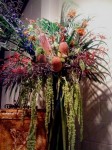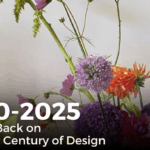History: Flemish designs are inspired by the Flemish paintings of artists during the medieval period between the 15th, 16th and early 17th centuries. “Flemish” refers to people from the medieval country of Flanders which is now covers parts of Belgium, France and Holland. Flemish painters depicted a wide variety of flowers that were gathered by British and Dutch merchants during their travels.
Typically, Flemish paintings depicted many different types of flowers and placed the most important blooms at the top of the arrangement. Paintings were done from models as Flemish arrangements disregarded seasonal availability and compatibility.
Style: Flemish style flower arrangements are almost always created in an oval shape. These arrangements feature a wide variety of different, mismatched flowers. Flemish designs are regarded for the excellent use of many different shapes, colors and textures.
Flowers Used: It is common to see only one or two stems of a particular flower in a Flemish flower arrangement. Though anything is permissible now, flowers commonly seen in Flemish paintings (the inspiration for these designs) are tulips, peonies, roses, marigolds, snowballs (Viburnum), iris and crown imperials (Fritillaria).
Foliage plays a smaller role (used only sparingly) in Flemish designs but soft, “weeping” grasses and other foliage are seen in Flemish designs. Bulb flowers are mandatory in a Flemish flower arrangement. Tropical flowers, wild flowers, fruit and accessories are also encouraged. Examples of popularly used accessories are birds’ nests, insects, reptiles, and shells. Also jewelry, rich fabrics and other things denoting wealth are seen in many Flemish arrangements.
Basic Characteristics: Flemish style flower designs are very lavish, full, and unique. Since any flower can be used, the flower vary widely.
Prominent flowers are placed in positions within the arrangement where they would receive the most attention. Slight breaks from the general oval shape draw the eye’s attention quickly, so Flemish flower design features prominent flowers at the tops and sides of the arrangement. Flowers may face all directions because Flemish painters wanted to show that many flowers also have beautiful profiles.
Depth is important in Flemish flower arrangements. Flowers can cascade over the edges of the container. This also adds to the dimension of the arrangement by playing an interesting contrast to the height of these arrangements.
Though this would not be done now, Flemish depictions of flowers showed imperfections because no perfections were found in nature. Leaves and flowers often featured bug holes, spots, and even the bugs themselves.
These designs are generally considered formal because of their mass and elaborate composition. They may considered informal as well when created in smaller arrangements.
Colors: Flowers in Flemish style arrangements typically feature warm hues such as yellow, orange and red. White, pale pink, and other pastels are also seen but less often. These are added to create contrast where needed. Flemish designs should feature touches of blue, especially pure Dutch Delft blue, wherever possible.
Containers Used: Flemish style flower arrangements commonly feature urns and containers with the same shape or appearance.
- Flemish Style Inspired Flowers
- Flemish Style Flower Arrangement


 Find Your
Find Your 






